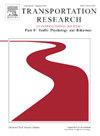Explaining Authoritative Control Interventions in Automated Driving to Support Driver Understanding, Trust, and Reliance
IF 3.5
2区 工程技术
Q1 PSYCHOLOGY, APPLIED
Transportation Research Part F-Traffic Psychology and Behaviour
Pub Date : 2025-05-08
DOI:10.1016/j.trf.2025.04.013
引用次数: 0
Abstract
Future automated driving systems (ADS) may be given the ability to fully block or takeaway driver control authority; for example, in cases of immediate danger. During these interventions, drivers will rely on the environment and the human–machine interface to explain the system’s behavior and to regain situational awareness. To examine how information can be structured to explain an authoritative control intervention, participants were exposed to three text message variations following interventions in two different driving scenarios in a simulator study. Text messages affected drivers’ objective and subjective responses to interventions. Including “Why” information about the reason for the automation’s behavior rather than “How” information about the control authority distribution increased understanding, trust, and appropriate reliance upon the automation. However, the evaluation of the automation’s behavior depended primarily on differences in the driving scenario, while text messages had only a minor influence. Driver gaze varied based on the driving scenario, with more glances to the HMI when driver control authority was taken away compared to when it was blocked. These findings have implications for human–machine interaction design, policy, and future research, highlighting the need for clear communication strategies during authoritative control interventions.
解释自动驾驶中的权威控制干预,以支持驾驶员的理解、信任和依赖
未来的自动驾驶系统(ADS)可能会被赋予完全阻止或剥夺司机控制权的能力;例如,在紧急危险的情况下。在这些干预过程中,驾驶员将依靠环境和人机界面来解释系统的行为并重新获得态势感知。为了检验信息结构如何解释权威控制干预,在模拟器研究中,N=46名参与者在两种不同驾驶场景的干预后暴露于三种不同的短信变化。短信影响司机对干预的客观和主观反应。包括关于自动化行为原因的“为什么”信息,而不是关于控制权限分布的“如何”信息,增加了对自动化的理解、信任和适当依赖。然而,对自动驾驶行为的评估主要取决于驾驶场景的差异,而短信只有很小的影响。驾驶员的目光根据驾驶场景而变化,当驾驶员的控制权被剥夺时,与被阻止时相比,他们更多地关注人机界面。这些发现对人机交互设计、政策和未来的研究具有启示意义,强调了在权威控制干预期间需要明确的沟通策略。
本文章由计算机程序翻译,如有差异,请以英文原文为准。
求助全文
约1分钟内获得全文
求助全文
来源期刊
CiteScore
7.60
自引率
14.60%
发文量
239
审稿时长
71 days
期刊介绍:
Transportation Research Part F: Traffic Psychology and Behaviour focuses on the behavioural and psychological aspects of traffic and transport. The aim of the journal is to enhance theory development, improve the quality of empirical studies and to stimulate the application of research findings in practice. TRF provides a focus and a means of communication for the considerable amount of research activities that are now being carried out in this field. The journal provides a forum for transportation researchers, psychologists, ergonomists, engineers and policy-makers with an interest in traffic and transport psychology.

 求助内容:
求助内容: 应助结果提醒方式:
应助结果提醒方式:


